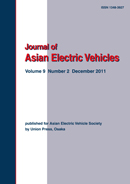Volume 7, Issue 2
Displaying 1-11 of 11 articles from this issue
- |<
- <
- 1
- >
- >|
Paper
-
2009Volume 7Issue 2 Pages 1261-1264
Published: 2009
Released on J-STAGE: January 29, 2010
Download PDF (3709K) -
2009Volume 7Issue 2 Pages 1265-1276
Published: 2009
Released on J-STAGE: January 29, 2010
Download PDF (1814K) -
2009Volume 7Issue 2 Pages 1277-1282
Published: 2009
Released on J-STAGE: January 29, 2010
Download PDF (3215K) -
2009Volume 7Issue 2 Pages 1283-1289
Published: 2009
Released on J-STAGE: January 29, 2010
Download PDF (887K) -
2009Volume 7Issue 2 Pages 1291-1296
Published: 2009
Released on J-STAGE: January 29, 2010
Download PDF (2134K) -
2009Volume 7Issue 2 Pages 1297-1302
Published: 2009
Released on J-STAGE: January 29, 2010
Download PDF (9429K) -
2009Volume 7Issue 2 Pages 1303-1308
Published: 2009
Released on J-STAGE: January 29, 2010
Download PDF (7774K) -
2009Volume 7Issue 2 Pages 1309-1317
Published: 2009
Released on J-STAGE: January 29, 2010
Download PDF (571K) -
2009Volume 7Issue 2 Pages 1319-1324
Published: 2009
Released on J-STAGE: January 29, 2010
Download PDF (2337K) -
2009Volume 7Issue 2 Pages 1325-1332
Published: 2009
Released on J-STAGE: January 29, 2010
Download PDF (4305K) -
2009Volume 7Issue 2 Pages 1333-1336
Published: 2009
Released on J-STAGE: January 29, 2010
Download PDF (2381K)
- |<
- <
- 1
- >
- >|
